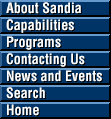Extreme Ultra Violet Lithography (EUVL) Milestone Celebration
Background
The Virtual National Laboratory
Lawrence Berkeley National Laboratory, Lawrence Livermore National Laboratory and Sandia National Laboratories in California have joined efforts as a Virtual National Laboratory to develop technology that arose from research capabilities in the 1980s.
Recognizing the potential value of their defense research for lithography — which the Defense Advanced Research Projects Agency considers a critical technology — researchers at Sandia and Lawrence Livermore national laboratories challenged themselves to demonstrate the early feasibility of working with extreme ultraviolet light. Their efforts evolved into research partnerships forged with industrial partners months before Congress enacted the Cooperative Research and Development Act (CRADA) of 1989, providing a process and an impetus for public-private research.
Lawrence Livermore’s early work with reflective coatings enabled systems that can manipulate extreme ultraviolet light (which is absorbed by most materials). Sandia researchers working nearby at the California site demonstrated new methods of creating extreme ultraviolet light.
Once the early stage research and development had been established, industry stepped in to foot the entire ensuing technology development bill. The Virtual National Laboratory was established in 1997 to work as a unit with the industrial consortium in the current CRADA project, which was extended from three years to run through early 2002.
The labs have drawn on their expertise in applying teams of many disciplines to create large, complex new devices under deadline, refine the product, and train others to replicate it.
Through the EUVL CRADA, labs’ researchers have been trained in proprietary risk-reduction approaches used by Intel Corp., and have gained insight and experience in working across organizational boundaries to fulfill a challenging peace-time objective. In keeping with the labs’ versatility, many EUVL researchers have rotated through the project during the course of the program, so that their newly acquired training and experience benefits other tasks and assignments throughout their careers at the labs.
Sandia National Laboratories (with main sites in Livermore, Calif. and Albuquerque, N.M.) has a long history of research in microelectronics to support its defense mission, and in fact, invented the laminar flow clean room in the 1950s. Sandia is responsible for development of the extreme ultraviolet light source for the lithography tool, and handles system integration and refinement of light-sensitive chemicals used in device patterning.
Lawrence Livermore National Laboratory, with several programs devoted to diagnostics and high-intensity laser research, brings a variety of skills to the project, such as special expertise in creating precision reflective optical coatings from multilayered materials, advanced optical testing methods and defect inspection technologies.
Lawrence Berkeley National Laboratory, which conducts only non-classified research, provides expertise in measuring the performance of components used in the tool’s print-making “camera,” using bright extreme ultraviolet light created by the Advanced Light Source synchrotron. LBNL facilities, supported by the DOE’s Office of Science, provide the world’s best standards for measuring reflectivity and uniformity.
Efforts by the three VNL members have been roughly divided into 40-45 percent each at Sandia and LLNL, with the remainder carried out at LBNL. Lawrence Berkeley National Laboratory (http://www.lbl.gov) and Lawrence Livermore National Laboratory (http://www.llnl.gov) are managed by the University of California for the U.S. Department of Energy. Sandia National Laboratories (with main facilities in California [ http://www.ca.sandia.gov ] and New Mexico [ http://www.sandia.gov ]) is operated for the U.S. DOE by a subsidiary of Lockheed Martin Corp. All three laboratories carry out a variety of national scientific and technical research programs.
Virtual National Laboratory contacts:
Nancy Garcia, negarci@sandia.gov, (925) 294-2932
Gordon Yano, yano1@llnl.gov, (925) 423-3117
| 